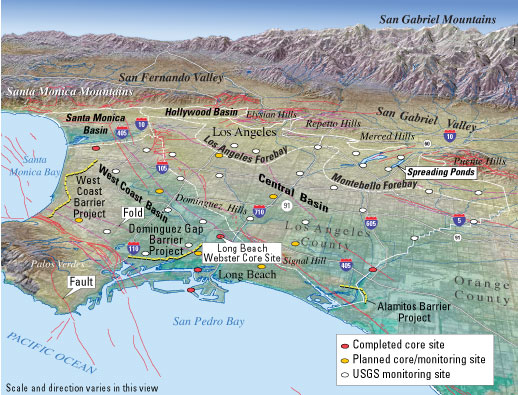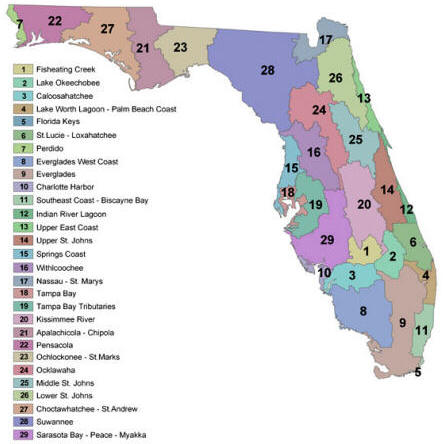The week that was, 10/18-24/2009
Posted on | October 25, 2009 | 3 Comments

From LA Sketchbook: Singing in the Main, LA Observed, October 20, 2009. Image courtesy of the artist. For more of Steve Greenberg's cartoons, click on the geyser.
The bill does not authorize a long-envisioned canal to move water around the delta southward. But … — “State water hearings to start next week,” Fresno Bee, October 24, 2009
The state would be required to reduce per-capita urban water use by 20% by 2020, but … — “State water hearings to start next week,” Fresno Bee, October 24, 2009, both Bee mentions via Aquafornia
“… that very well may have been a statistical blip.” — Joe Ramallo, Department of Water and Power spokesman on 44 major leaks in the month of September, “Three more water mains rupture in Los Angeles,” LA Times, October 21, 2009
“It’s a serious problem, don’t get me wrong, but it’s been a problem for a long long time.” — Los Angeles Department of Water and Power general manager S. David Freeman interviewed after three pipe ruptures in one day, “Water main roulette,” the Patt Morrison Show, KPCC, October 20, 2009. Via LA Observed
“We’re not convinced it’s a water main break. It could be a fire pipe.” — Thomas Bagley, spokesman for the Boston Water and Sewer Commission, “Water main break closes Boston office building,” Boston Herald, October 19, 2009
Old Chatham Golf Club directors had voted in 2001 to waive the governor’s monthly membership dues. That saved [former North Carolina governor Mike] Easley about $50,000 while he was in office, a break he did not reveal on financial disclosure forms. — “In drought, Easley’s club got water,” Raleigh News and Observer, October 18, 2009
 “I grew up in Los Angeles … The ocean is right there. And if you pull the groundwater down, surprise, surprise, the saltwater comes in. And if they had not found a way of reducing the quantity of water they pumped, and doing a variety of other things, they would have had to give up the groundwater basin to saltwater.” — Nobel laureate Elinor Ostrom, Waterwired, October 23, 2009
“I grew up in Los Angeles … The ocean is right there. And if you pull the groundwater down, surprise, surprise, the saltwater comes in. And if they had not found a way of reducing the quantity of water they pumped, and doing a variety of other things, they would have had to give up the groundwater basin to saltwater.” — Nobel laureate Elinor Ostrom, Waterwired, October 23, 2009
… if it were up to me I would hire the Bloomington Workshop in Political Theory and Policy Analysis, started at Indiana University by this year’s co-winner of the Nobel Prize in Economic Science, Elinor Ostrom, and her husband, Vincent, to come up with a long-term solution to irrigation in the San Joaquin Valley. — Alan Boch,”Something fishy in the Sacramento Delta,” Orange County Register, via Aquafornia
Ostrom and Williamson deserve the Nobel for doing the best kind of economics — the economics that enlighten us and give us ways to improve our lives. — David Zetland, Aguanomics, *October 12, 2009
“We are a clean outfit.” — LADWP general manager S. David Freeman, “Water main roulette,” the Patt Morrison Show, KPCC, October 20, 2009
They showed this chart at the Water Plan meeting last week. I like it because it shows the different ways to address the gap between what we’ve got and what we want to have. — On the public record, Sacramento California, October 21, 2009. Via Aquafornia

Major identified watersheds of Florida. Source: Florida Department of Environmental Protection. Click to enlarge.
... you’d think those we elected to be stewards of the state would protect [water] with the ferocity of a mama gator guarding her nest. Sadly, you’d be wrong. — Diane Roberts, professor of English at Florida State University, “Protect the water, not polluters,” St Petersburg Times, October 18, 2009
“These fines are meaningless to huge companies.” — Mark Lloyd, chief executive of the Angling Trust, “South West Water tops pollution prosecutions table,” Western Morning News, October 21, 2009
What utilities put into the air is regulated. Not so the toxics — arsenic, lead, cadmium — they discharge into the water. — “Clean Water: Still elusive,” New York Times editorial, October 21, 2009
“A lot of people in government see it as a risky project, and kind of hope other things come along that make it unnecessary.” — Kenneth Pomeranz of the University of California Irvine, asked about Chinese proposals to dam the Brahmaputra River in Tibet, “India, China and water security,” The Hindu, October 21, 2009
If this winter is as lacking in rainfall as the last one, then by next summer Israel will have to take drastic steps … — ‘Water reserves may be drained by 2010,’ Jerusalem Post, October 20, 2009
“Stop the radical environmentalists. Save your water. Save your jobs. Vote Republican.” — from “State GOP tries to steal Dems fire over water,” San Francisco Chronicle, October 19, 2009
When they do laundry, their clothes get stained. — “What are these black particles…” Charleston Post and Courier, October 18, 2009
Both mayoral candidates Ludmya “Mia” Love and Jeff Francom believe the $62 million water-delivery contract the city entered into on behalf of the LDS Church was a brilliant long-term planning move. — “LDS water deal is praised,” Salt Lake Tribune, October 21, 2009
“I don’t know any engineer that calculates on 6 1/2 inches of [rain] water in an hour.” — Charlie Whitmire, new home developer, “Fury over flooding,” Chattanooga Times Free Press, October 22, 2009
One type of vehicle is always within sight on Yemen’s roads: the water truck. — “Yemen could be the first nation to run out of water,” The Times, London, October 21, 2009
“When chicken is cheaper than bait, there’s a problem with the system.” — John Page Williams, The Capital, Annapolis, October 20, 2009, “What’s missing from the bay plan …”
*This post has been updated. 10/25: A faulty link to the Yemen item has been corrected. Thank you GrokSurf’s San Diego for the quick spot. Also, the David Zetland item has been added despite the technicality that it comes from The week before This week that was. 10/26: The graph from On the public record has been added.
Comments
3 Responses to “The week that was, 10/18-24/2009”
Leave a Reply




October 26th, 2009 @ 3:12 pm
Here’s the key paragraph in the Yemen story:
Yemen is set to be the first country in the world to run out of water, providing a taste of the conflict and mass movement of populations that may spread across the world if population growth outstrips natural resources [my emphasis].
Population growth is probably the root cause of our water shortages and we can conserve and ration and raise the price all we like but unless we solve the growth problem, our future looks dry indeed.
October 27th, 2009 @ 9:29 am
Thanks for allowing me another week of relevance!
🙂
Great zeitgeist post:
1) Tell Boch that I can stand in for Lin.
2) I will cover the Yemen thing. Demand side is not just population, but use/capita
3) Carson is so dead on, but I’ve written on this numerous times. When will water managers rise from their comas?
October 27th, 2009 @ 10:50 am
@David I think we’re in agreement: use/capita management can mitigate the problem but indefinite population growth competing for a finite resource (renewable doesn’t apply in this context) is unsustainable. We have to work on both.